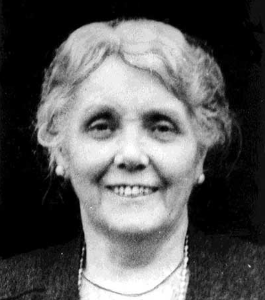Catherine Hogg Blair facts for kids
Quick facts for kids
Catherine Blair
|
|
|---|---|
 |
|
| Born |
Catherine Shields
8 January 1872 Byres Farm, Bathgate, Scotland
|
| Died | 18 November 1946 (aged 74) North Berwick, Scotland
|
| Nationality | Scottish |
| Other names | Catherine Blair Catherine Hogg Blair |
| Known for | Suffragette and founder of the Scottish Women's Rural Institute Establishing Mak'Merry Pottery Studio |
|
Notable work
|
Rural Journey: A History of the S.W.R.I. From Cradle to Majority |
| Parents |
|
Catherine Hogg Blair (née Shields; 8 January 1872 – 18 November 1946) was a Scottish suffragette, magistrate, founder of the Scottish Women's Rural Institute (SWRI), and member of the Women's Social and Political Union (WSPU). Blair was a passionate campaigner and spokeswoman for rural women, dedicated to doing 'all in her power to further the interests of women'. In 1940, Blair's history of the Scottish Women's Rural Institute Rural Journey: A History of the S.W.R.I. From Cradle to Majority was published, summarising the achievements and goals of the organisation since its inception in 1917. Blair was also a skilled potter, founding Mak'Merry pottery studio in the town of MacMerry, East Lothian.
Contents
Early life and family
Catherine Blair was born in Byres Farm, Bathgate to Susan Jemima Hogg and James Shields. One of six children, Catherine attended Bathgate Academy The Shields family moved to Dolphingstone Farm, near Tranent. Catherine met and married Thomas Blair, a farmer, in 1894. The couple moved to Hoprig Mains Farm, near Gladsmuir, East Lothian and had four children.
Support of suffrage
Blair was an active member of the Women's Social and Political Union (WSPU), chaired local meetings and wrote to the press. Although an ardent defender of militancy, she did not participate in militant protests because of her young family. Blair established her farm as a clandestine refuge for Scottish suffragettes who had been released from prison under licence as a result of the Cat and Mouse Act. Her husband, Thomas Blair, was supportive, resigning his vice-presidency of the local Liberal party because of the government's treatment of the suffrage question. Blair was a friend of a fellow suffragette, Nannie Brown, who also worked on the Scottish Women's Rural Institutes.
During the 1911 census, to protest that she would only be recorded as the "wife" of Thomas Blair, she moved herself and her children to a nearby barn so that the census form would need to show her as a person in her own right. Blair's actions were part of a wider boycott of the 1911 census, enacted by suffragette organisations.
Scottish Women's Rural Institute
In 1917, Blair identified the need for a Scottish example of the emerging Women's Institutes movement and consequently founded the Scottish Women's Rural Institute. The first SWRI meeting was held in Longniddry, East Lothian, and Madge Watt was there from Canada – 37 women became members. The SWRI created the chance for rural women to forge new social networks and share skills with one another; something Blair was passionate about understanding the obligatory ties women had to their home lives.
Blair had suggested from its inception that the Scottish Women's Rural Institute should not ‘confine themselves to matters of a purely domestic character’. Instead, she envisaged that the organisation would provide countrywomen with an opportunity to voice their concerns over life in rural areas, with housing being a ‘prominent talking point’. Moreover, she suggested that the ‘future life of their country depended on agricultural development’ and in turn, this depended ‘very largely’ on better housing and social conditions. Although the SWRI claimed to maintain a non-political stance, Blair channelled her belief in female equality into the organisation, agitating members to challenge the status quo regarding the poor rural housing conditions.
Catherine Blair was involved in the 1919 Memorandum on Rural Housing, commissioned by the Scottish Board of Agriculture, which sought to gather women’s housing experiences throughout rural Scotland. The Board encouraged ordinary members of the Scottish Women's Rural Institute to work out and express what their housing requirements and priorities were.
Blair's Mak'Merry pottery studio was affiliated with the Scottish Women's Rural Institutes. The appeal of Mak'Merry pottery was far-reaching becoming ‘a feature of many a rural show'. Upon Catherine Blair's death in 1946, it was noted in her obituary that there was an established market for her pottery in America. She also helped set up the Lothian Home Arts Guild of Craftswomen.
Later life and legacy
In 1921 she became a magistrate.
Blair died in North Berwick on 18 November 1946.
In 2021, Blair was one of a collection of Scottish suffragists celebrated in a deck of cards distributed as part of an education pack to 100 schools around the country.

